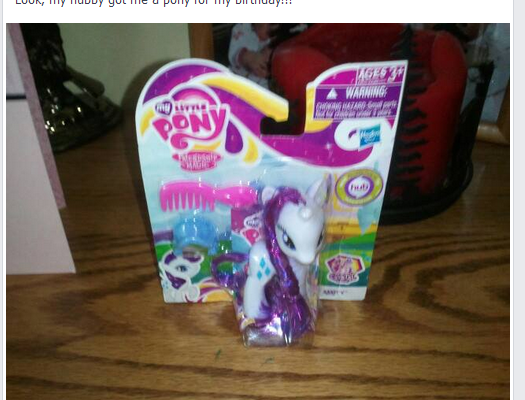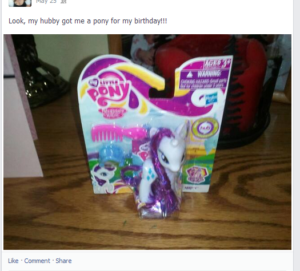Am I the only one who just noticed that it’s Wednesday? The holiday week with the free day is completely screwing me up.
Just to make this a relevant post:
Spend less!
Save more!
Invest!
Wee!
The no-pants guide to spending, saving, and thriving in the real world.

For the past couple of years, my daughters have been riding in horse shows with a local saddle club. We’ve been lucky in that my wife’s cousin has let us borrow her horse for the shows, so costs have been minimal.
Unfortunately, that horse isn’t available this year. We knew that a few months ago, so the plan was to take a year off from the shows and focus on lessons, to get the girls some real skills. We found a great instructor at a stable about 30 miles from our house. Since we live less than two miles from the border of the biggest city in the state, that’s a comparatively short drive.
We pay her $200 per month for 1 lesson per week for both girls. They each get 30-45 minutes on the horse during each lesson.
Now that show season has started, the plan seems to have changed. The girls will be riding a different borrowed pony tomorrow. The shows cost about $50 for registration, lunch, and gas. Our club has 1 show per month, but my wife has assured me they’ll only be hitting three shows this season and limiting the number of events to keep the cost down.
The direct costs aren’t too bad, but there’s a problem with keeping-up-with-the-Joneses accessorizing. Vests and boots and helmets and belts and shirts, oh my.
I’d guess our costs for the summer will be $300 per month.
One thing we’ve been considering is buying a pony. We can get an older pony for around $500-1000. Older is good because they are calmer and slower. Boarding the thing will cost another $200 per month. We’ve been slowly accumulating the stuff to own a horse, so I’m guessing the “OMG, he let me buy a horse, now I need X” shopping bill will come to around $1500, but I’ll figure $2000 to be safe. We already have a trailer, a saddle, blankets, buddy-straps, combs, brushes, buckets, rakes, shovels, and I-bought-this-but-I-will-just-put-it-in-the-pile-of-horse-stuff-so-Jason-will-never-notice stuff. We’re certainly close to being ready to buy.
(FYI: If you’re starting from scratch, don’t think you’re going to get into horse ownership for less than $10,000 the first year, and that’s being a very efficient price-shopper.)
So we’re looking at $5400 for a horse, gear, and boarding the first year. If we cancel the lessons, by spring we’d have $2000 of that saved and most of the rest can be bought over time.
On the other hand, if we go that route, we’ll never save enough to buy the hobby farm we’re looking for.
Decisions, decisions. I should just buy a new motorcycle. Within a year, I win financially.
Car insurance is mandatory in Colorado. Colorado law on car insurance changed in 2003 when the state changed to a fault-based system from a no-fault system. Even more requirements were added in 2009 for drivers, namely, a mandatory $5,000 in medical payments coverage.
Many of the other changes made to Colorado car insurance requirements were made to help prevent claim abuses and reduce the cost of insurance premiums for drivers in the city. The ‘tort’ or fault-based system requires that fault must be established before a claim is paid by an insurance company.
According to data released by the National Association of Insurance Commissioners, the average cost of auto insurance in Colorado was $777. This is way below the national average of $841 and far below the most expensive state, New Jersey, which had an average expenditure of $1,254 in annual premiums.
Colorado Insurance requirements
The state requires all drivers to have liability coverage at the least. This ensures that the other party and their property will be compensated in an accident that is your fault. According to insurance-comparison site, CoverHound, the minimum coverage for car insurance in Colorado should include:
Additional car insurance
Having insurance coverage meeting the minimum requirements of the law in Colorado will save you from being arrested for inadequate insurance. However, your insurance may not provide you with adequate coverage in case of an accident. Therefore, it’s important to consider the following car insurance options.
While car insurance is a mandatory in Colorado, several drivers still drive without auto insurance. Figures released by the Insurance Research Council estimate that 16.2 percent of motorists in the state are uninsured. This is slightly above the 12.6 percent national average. The scary thing about not having this coverage is you never know when you’re going to get in an accident, let alone an accident with someone who’s underinsured, or uninsured altogether. As you can probably guess, if someone isn’t willing to pay an insurance premium to protect their financial means, they probably don’t have much financial means to protect in the first place, thus leaving you destitute in the event of an accident, regardless of fault. Bottom line: uninsured/underinsured motorist coverage protects your expenses in this situation.
Due to the aforementioned legislation passed in 2009, insurance providers are required to offer motorists $5,000 in med pay coverage as part of their insurance coverage. This is offered as part of every car insurance policy, and can be adjusted in $1,000 increments. You however, have the choice of opting out, but you have to send a rejection form. You can also choose to up your coverage to as much as $100,000.
Liability coverage ensures that the other party’s expenses are covered in the event you cause an accident, but what about damage to your own car? Collision coverage takes care of any damages to your car regardless of who’s at fault. The insurance also covers you for damage caused by hitting other objects with your car, such as a tree, or streetlight.
This ensures that you are covered for any damage that is caused to your car that doesn’t involve a collision (e.g. fire, falling objects, flood and hail). It also provides cover for the loss of your car through theft and other perils such as explosions.
If you purchase your car through a loan, your lender may require you to take out a comprehensive coverage policy. You can choose to have a higher deductible in order to reduce the cost of your premium.
Cost of violations
There are various penalties set by the state to ensure that motorists have adequate insurance. You may be penalized for failing to provide evidence of insurance or for purchasing inadequate insurance. Some of the penalties and fines include:
It is important to understand your state laws and your own financial situation when choosing insurance. Your policy should not only meet state law requirements but your personal requirements as well. If it doesn’t, then what’s the point of having it in the first place?
This is a guest post.
A few weeks ago, on my way to work, while merging onto the highway, a soccer mommy in an SUV decided that she was going to accelerate to fill the opening I was going to use. Not before I got there, which would have left her in the right, if still a jerk, but as I was moving into the lane.
The entire reasoning was that she could be rude and dangerous under the assumption that I would be more civilized and back down, allowing her to indulge her little fantasy about how the world works. Luckily I saw her speed up, and had time to move out of the way. Physics very nearly taught her an expensive lesson.
This is similar to the people who think they’ll be safe because “nothing has happened before” or think “He won’t hurt me because I;m a good person” when confronted with a mugger.
This is magical thinking. Basing assumptions of other people’s actions on nothing more than your personal hopes and biases. The truth is, your halo does not provide a shield. Your luck at dodging criminals while strolling through bad neighborhoods does not circumvent statistical likelihood and your jerkface attempt to run me into a guard rail had better be backed by the stones to deal with a wreck.
Magical thinking, wishful thinking, and baseless hope are not rational methods of running your life. Criminals hunt for victims who wrap themselves in a smug, yet naïve, superiority. Murphy’s Law is waiting for someone arrogant enough to think that the laws of physics don’t apply when you’re commuting. The only rational means of predicting the behavior of others is to look at the signals they are actually producing.
Someone tentatively trying to squeeze into an opening in traffic is far more likely to submit to your passive aggression than the guy who merges with a turn signal and the gas pedal.
Someone in the park after hours in a hoody is more likely to hurt you than the guy in running shorts.
The guy lurking in the shadows of the parking ramp, refusing to make eye contact is a more likely mugger than the suit trying to find his Lexus.
A million years of evolution have given us an incredible ability to detect danger. A few hundred years of relative peace at the end of a few thousand years of relative civilization have not erased that ability, it has just convinced us to ignore our instincts under the mistaken assumption that all predators live in the jungle.
Fear has survival value. Don’t allow your rational brain to override your lizard brain completely. Let your fear keep you safe.
It’s a sad day when kids stop believing in Santa Clause, the Tooth Fairy, and fairies.

Not because I enjoy lying to my kids, but because–on the day they stop believing–a piece of their innocence is lost. An unforgettable, valuable part of childhood dies.
Believing in magic is a beautiful thing.
Do you remember the last time you looked around the world with a sense of wonder? When seeing a puppy form in the clouds was a miracle? When the idea of an ant carrying 1000 times its own weight was something worth watching? When the impossible goodness of a fat man squeezing down your chimney fills you with hope instead of making you call 911?
Do I believe in Santa?
Of course not, but I believe the concept of Santa is worthy of my children’s belief. I don’t want them to lose that innocence and wonder.
When my teenager was young, he asked if Santa was real. I responded by asking what he thought. When he told me he didn’t believe, I offered to let Santa know. His panic told me he wasn’t ready to give up the magic.
The day that conversation didn’t cause a panic, he looked hurt, like he’d lost something precious. He had.
His world of magic was gone.
The he asked why I had spent his lifetime lying to him. I told him the truth. I said I couldn’t bear to be the one to shatter his belief in magic before he was ready.
Then, I informed him that he was in on the conspiracy. He was not allowed to ruin it for anyone else. Not his sisters, not his friends.
That Christmas, my little boy helped me stuff stockings, which was an odd feeling.
The magic was over, but we still got to share the magic of his cousins and sisters.
Last week was our family vacation. This year, we decided to keep it cheap, since we raided our savings a few months ago to cover my son’s vision therapy.
Here’s what we did:
Friday (Yes, I started vacation on a Friday): My wife worked a half day, then we drove to visit my parents, roughly 120 miles north of our house. $110 for gas, round-trip, and $10 for drive-through lunch. $120 total.
Saturday: We went to the county fair and Dairy Queen. $18 for admission. $30 for ride tickets. $35 for food and ice cream. The ride tickets were totally worth it. My son and I discovered that he can handle the fun rides, which thrills me. $83 total.
Sunday: We had a picnic at the bottom of Inspiration Peak, the third highest point in Minnesota, followed by a hike to the top. That evening, my brother, his wife, my wife, and I tricked my parents into babysitting and escaped for several hours of adult time. After a couple of overpriced drinks at a crap restaurant, we went somewhere nicer and cheaper. A nice dinner, a few drinks, and a round of drunken go-karts later, we spent $90 for the evening.
Monday: Back to the go-kart park for the afternoon, and the return drive home in the evening. The go-kart park included 3 rounds of go-karts, mini-golf, and a round of bumper boats. $40.
Tuesday: A hands-on kids museum, a natural history museum that was hosting a portable planetarium, and a teppenyaki restaurant. We used museum passes for the museums, so this cost a total of $160. By far, the most expensive part was the restaurant. The museums cost a combined $30.
Wednesday: We spent the day at the Monster Mall’s indoor theme park, Nickelodean Universe, where we tested my son’s ability to handle the fun rides for $70. Then we ate at the Rainforest Cafe for $116, and we got my wife’s anniversary present, a family portrait at an “old time” photo studio. We chose a 1920s theme. I must say, I look dashing in a zoot suit. $260 total.
Thursday: My wife had to work on Thursday because she was short of vacation time, so I had the brats to myself. We went to a pick-your-own apple orchard where we picked a large bag of apples, a bottle of real, locally-made maple syrup and 3 cookies-on-a-stick. Afterwards, Brat #1 and I went to a Chinese buffet and the comic book store while the women-folk went to a saddle-club meeting. $60 total.
Friday: We had a fried chicken picnic at the largest playground in the area, and otherwise took it easy. $12.
Saturday: On Saturday, my girls rode in a horse show for the saddle club while my wife put in her volunteer work hours. Registration and the food for the potluck ran $40.
Sunday: I had to teach a gun class, so I made money, instead of spending it. My wife and kids played around the house.
Total, our vacation cost us $865, for 10 days of memories. If we would have skipped the restaurants, it would have cost $465, but we wanted those experiences, too. Our vacation fund has $906 in it, so we did all right.